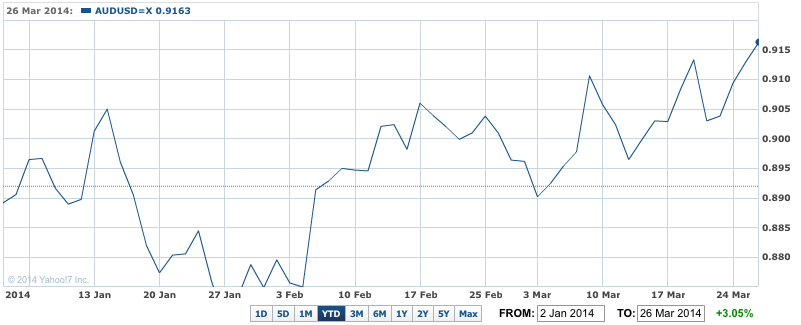The Australian dollar jumped towards 93 US cents last night as markets ignored a fitful attempt from Reserve bank Governor, Glenn Stevens to talk the currency lower in a major speech in Hong Kong yesterday.
The currency hit a new four month high of 92.45 in offshore trading – up half a cent from the Sydney close and 2 cents in the past week.
It was trading around 92.20 US cents in early Asian trading this morning.
Wall Street fell by around 0.6% to 1.4%, our market will open down 33 points, reclaiming much of yesterday’s rise, gold eased to $US1,305 an ounce and oil rose by a few cents.
The dollar rose on Mr Stevens’ comments on the strength of the Australian housing construction boom that seems to have attracted support for the currency and the belief that interest rates here will rise sooner than later – a misplaced guess.
That’s not ‘new’ news – Mr Stevens and the bank have made the same point several times this year without getting the same reaction from the market.
The currency is now more than 3% higher than the start of the year when it was just over 89 US cents. It’s also nearly 8% above its 2013 low of 86.60 US cents and is rapidly eroding the gains made since its most recent high of just over $US1.05 11 months ago.
The currency’s appreciation threatens to put a new straitjacket over the economy, especially the trade account which is looked to as one of the key drivers of growth as the economy transitions from the resources investment boom to broad domestic growth.
AUDUSD YTD – Dollar jumps on RBA Governor Stevens’ upbeat take on the economy

The rise last night and this morning is despite Mr Stevens pointing out that the bank expects the terms of trade to fall further from the 20% drop already seen from the September, 2011 peak.
In a Question and Answer session following his speech, Mr Stevens did say the currency was still too high, but refrained from mentioning any specific targets – unlike his end of year comment that around 85 cents was his target.
"Our assumption is that the terms of trade will fall further. We think commodity prices will be softer than where they have been in recent past," Mr Stevens said. "It will be quiet a surprise if that comes to pass if the Australian dollar doesn’t depreciate along with that." There was no mention of possible intervention, as there was late last year.
The absence of any attempt to talk the dollar lower saw the market focused on Mr Stevens’ more upbeat assessment of the Australian economy.
In his speech, the RBA governor said there were encouraging early signs of a transition from mining-led demand growth to domestic consumption and the economy might strengthen later this year.
”This outlook is, obviously, a balance between the large negative force of declining mining investment and, working the other way, the likely pick up in some other areas of demand helped by very low interest rates,” Mr Stevens said.
"Our assumption is that the terms of trade will fall further. We think commodity prices will be softer than where they have been in recent past.
"It will be quiet a surprise if that comes to pass if the Australian dollar doesn´t depreciate along with that.
"The long running equilibrium of the exchange rate is probably lower and we have been quiet consistent in saying that.
”The lower exchange rate since last April and the improved economic conditions overseas also help," he pointed out.
That gain has been eroded by the currency’s strength in the past month.
The RBA governor said there were "promising signs" from non-mining sectors of the Australian economy, where growth is needed to offset declining mining investment.
"There is encouraging early evidence that the so-called handover from mining-led demand growth to broader private demand growth is beginning," he said.
He said household consumption had strengthened in recent months (as we have seen with retail sales and in the December national accounts), there are "abundant signs of confidence" in the housing market, and business confidence has improved, Mr Stevens said.
"Recent data shows stronger household consumption over the summer. The latest surveys and our own liaison confirm this, and suggest that retailers are more optimistic than they were a year ago. That said, we expect consumption spending to grow in line with income or perhaps a little faster, but not at the pace seen in the years prior to the financial crisis," Mr Stevens said in his speech.
"We certainly see abundant signs of confidence in the housing market. Dwelling prices have seen a broad-based rise of 10 per cent in the past year and are now about 5 per cent above the previous peak in 2010.
"Initially this was not associated with very much at all in the way of faster housing credit growth. That has now picked up a little, though it remains far below the rates seen in the 1990s and 2000s. The pick-up is most noticeable for investors, who need to take care with the amount of leverage they take on.
"It is clear that dwelling construction activity will rise strongly over the period ahead. Over the past three months, approvals to build private dwellings were at the highest rate for at least three decades. This increase is welcome, certainly at an aggregate level, since on most estimates Australia’s additions to the dwelling stock have been running at a rate below population growth over recent years.
But the transition away from a resources-led economy could prove bumpy, he pointed out, repeating a point he and others in the bank have made many times in the past year.
"The fact is that no one can say with certainty just how smooth a handover will occur," Mr Stevens said.
"Nor can anyone pretend to be able to fine-tune it."













